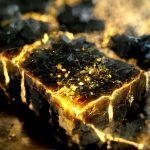
Table of Contents
Introduction: The Beauty and Versatility of Gold
Gold has always been a symbol of luxury, prestige, and beauty. Gold is also naturally inert and non-toxic, making it a perfect material for culinary arts. Edible gold leaf and flakes are used primarily in the gourmet food industry as an elegant and glamorous touch to a dish, bringing a unique aesthetic and artistic dimension to cuisine. Edible gold is not just pleasing to the eye but also offers potential health benefits, including its antioxidant and anti-inflammatory properties. In this article, we will delve deeper into the world of edible gold, including its history in the culinary arts, its modern-day popularity, and its many uses in the kitchen.
A Brief History of Edible Gold in the Food Industry
Edible gold has a long and fascinating history in the culinary arts. Gold as a food decoration dates back to ancient times, where gold was used to enhance the beauty of foods and as a symbol of wealth and prosperity. Several ancient civilizations, including the Greeks, Romans, and Egyptians, were known to use gold leaf in their cuisine. In medieval Europe, edible gold was often used for medicinal purposes, believed to have health benefits that included the ability to cure various ailments. Today, gold leaf remains a popular addition to gourmet cuisine, often paired with desserts and confectionery.
The Role of Gold in Modern Cuisine and its Popularity Among High-End Restaurants
In modern times, gold leaf and flakes have become a staple in high-end cuisine. Although its use may seem extravagant, gold has become more accessible and is now used in a variety of food products, from chocolates to cocktails. One reason for the popularity of edible gold may be its ability to elevate a dish visually, adding a luxurious element that appeals to the senses. Additionally, the unique texture and delicate nature of gold make it a challenge to work with, adding an extra layer of culinary finesse that many chefs relish.
The Benefits of Consuming Edible Gold for Health and Wellness
Edible gold not only adds beauty to your food plates but also offers potential health benefits. Gold is rich in antioxidants, which help prevent damage to cells by reducing oxidative stress. Additionally, it has anti-inflammatory properties, which may help reduce chronic inflammation in the body. Many health experts believe that edible gold may help with detoxification and improving brain function. While more research is needed to establish the full range of benefits, there is no denying that edible gold can contribute to a healthier diet.
The Different Types of Edible Gold Leaf and Flakes and Their Culinary Uses
There are different types of edible gold leaf and flakes used in the food industry depending on the grade, weight, and desired effect. The most common types include pure gold, which is 24-karat and considered the most luxurious, and edible gold spray, which can be applied directly. Edible gold leaf and flakes are delicate and are usually added after the dish is prepared or right before it is served. In culinary arts, gold leaf and flakes are often used to decorate pastries, cakes, chocolates, and beverages, adding a touch of luxury to any dish.
The Ethical and Sustainable Sourcing of Edible Gold
It is essential to recognize the sourcing of edible gold, especially regarding ethical and sustainable practices. Gold mining can have devastating environmental and social implications, including deforestation, pollution, and abuse of human rights. However, there are now companies that engage in fair trade gold sourcing to ensure environmental and social responsibility are upheld. These companies’ efforts reflect a growing awareness of the importance of ethical and sustainable sourcing of luxury commodities, and consumers can use their purchasing power to support them.
How to Use Edible Gold Leaf and Flakes in Cooking and Baking
Edible gold leaf and flakes require a delicate touch when used in culinary applications. They are typically fragile and can break easily, so handling them with care is essential. Edible gold is tasteless and odorless, so it will not affect the overall flavor of the dish. When used in baking, it is best to apply a small amount to the top of the finished product, such as on top of macarons or chocolate truffles. In cocktails, a small sprinkle of gold flakes can be added to the rim of a glass to give it an extra-special touch.
Edible Gold as a Symbol of Celebration and Luxury
Edible gold has long been associated with luxury, elegance, and celebration. Adding a touch of gold to your dish or drink can elevate it to a level of sophistication that makes any occasion special. Whether it is a wedding, anniversary, or birthday celebration, edible gold is a way to mark these milestones with an extra dose of luxury.
Conclusion: Edible Gold as a Glimpse into the World of Gourmet Cuisine
Edible gold is not just a decoration; it is a symbol of elegance, luxury, and beauty. Its versatility and ability to enhance the visual appeal of food and drinks make it a valuable commodity in gourmet cuisine. Edible gold also offers potential health benefits and can be sourced sustainably and ethically. As an ingredient in the culinary arts, edible gold provides a glimpse into the world of culinary finesse and artistic flair that characterizes gourmet cuisine.





